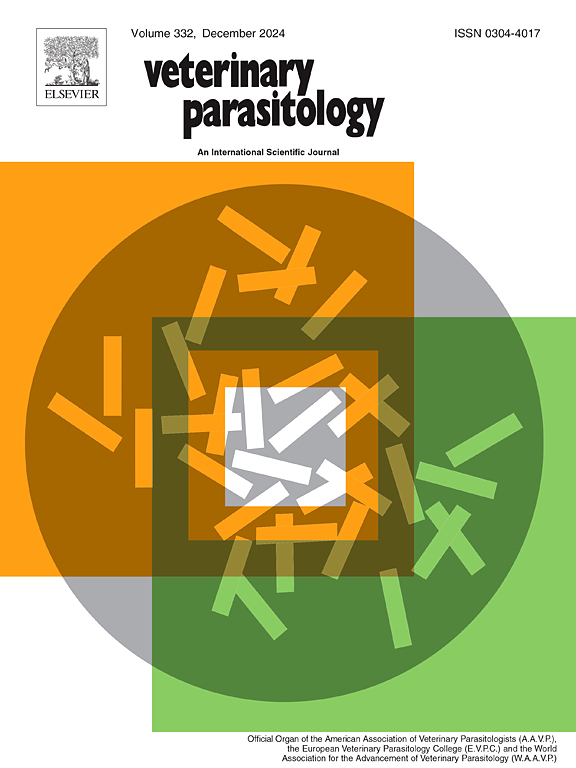瑞士自由放养的肉食动物和野猪中旋毛虫的检测
IF 2
2区 农林科学
Q2 PARASITOLOGY
引用次数: 0
摘要
狼(Canis lupus lupus)和猞猁(lynx lynx)是瑞士官方监测的物种。对死者进行尸检并收集基线健康数据。该程序包括评估不同的传染原,包括引起应呈报的人畜共患感染的旋毛虫。2009年5月至2023年5月期间,在旋毛虫病国家参考实验室用人工消化法对100只狼和250只猞猁进行了测试。此外,还分析了主要由瑞士猎人提交的8838只野猪(Sus scrofa)、27只红狐(Vulpes Vulpes)和23只欧洲獾(Meles Meles)的肌肉样本是否感染旋毛虫。狼16/100(16 %)、猞猁41/250(16.4 %)、红狐2/27(7.4 %)、獾0/23(0 %)、野猪1/8838(0.01 %)检出旋毛虫幼虫。所有阳性样本进一步采用多重PCR检测,在种/基因型水平上对寄生虫进行鉴定。在14只狼、33只猞猁、2只红狐和1只野猪身上检出布氏绦虫和1只猞猁身上检出螺旋绦虫。在9个案例中,分子鉴定是不可能的。虽然瑞士在过去的几十年里没有发现家猪和马感染旋毛虫的病例,但我们发现这些寄生虫,最常见的是布氏弓形虫,仍然存在于瑞士的野生动物中。因此,对野味的检验仍然非常重要,不能排除在家畜中发生散发感染的可能性。本文章由计算机程序翻译,如有差异,请以英文原文为准。
Detection of Trichinella spp. in free-ranging carnivores and wild boars in Switzerland
Wolves (Canis lupus lupus) and lynx (Lynx lynx) are officially monitored species in Switzerland. Deceased individuals are subjected to post-mortem examination and collection of baseline health data. The procedure includes an assessment of different infectious agents, including Trichinella spp., the cause of a notifiable zoonotic infection. Between May 2009 and May 2023, a total of 100 wolves and 250 lynx were tested at the National Reference Laboratory for Trichinellosis by the artificial digestion method. Additionally, muscle samples from 8838 wild boars (Sus scrofa), 27 red foxes (Vulpes vulpes), and 23 European badgers (Meles meles), mainly submitted by Swiss hunters, were also analysed for Trichinella infection. Trichinella spp. larvae were detected in 16/100 (16 %) wolves, 41/250 (16.4 %) lynx, 2/27 (7.4 %) red foxes, 0/23 (0 %) badgers, and 1/8838 (0.01 %) wild boars. All positive samples were further tested by multiplex PCR to identify the parasite at the species/genotype level. Two species were detected: T. britovi (in 14 wolves, 33 lynx, 2 red foxes and 1 wild boar) and T. spiralis (in one lynx). In nine cases, the molecular identification was not possible. Although no cases of Trichinella spp. infection in domestic swine and horses were detected in the last decades in Switzerland, we revealed that these parasites, most frequently T. britovi, are still present in Swiss wildlife. Therefore, inspection of game meat remains very important, and the occurrence of sporadic infection in domestic animals cannot be excluded.
求助全文
通过发布文献求助,成功后即可免费获取论文全文。
去求助
来源期刊

Veterinary parasitology
农林科学-寄生虫学
CiteScore
5.30
自引率
7.70%
发文量
126
审稿时长
36 days
期刊介绍:
The journal Veterinary Parasitology has an open access mirror journal,Veterinary Parasitology: X, sharing the same aims and scope, editorial team, submission system and rigorous peer review.
This journal is concerned with those aspects of helminthology, protozoology and entomology which are of interest to animal health investigators, veterinary practitioners and others with a special interest in parasitology. Papers of the highest quality dealing with all aspects of disease prevention, pathology, treatment, epidemiology, and control of parasites in all domesticated animals, fall within the scope of the journal. Papers of geographically limited (local) interest which are not of interest to an international audience will not be accepted. Authors who submit papers based on local data will need to indicate why their paper is relevant to a broader readership.
Parasitological studies on laboratory animals fall within the scope of the journal only if they provide a reasonably close model of a disease of domestic animals. Additionally the journal will consider papers relating to wildlife species where they may act as disease reservoirs to domestic animals, or as a zoonotic reservoir. Case studies considered to be unique or of specific interest to the journal, will also be considered on occasions at the Editors'' discretion. Papers dealing exclusively with the taxonomy of parasites do not fall within the scope of the journal.
 求助内容:
求助内容: 应助结果提醒方式:
应助结果提醒方式:


